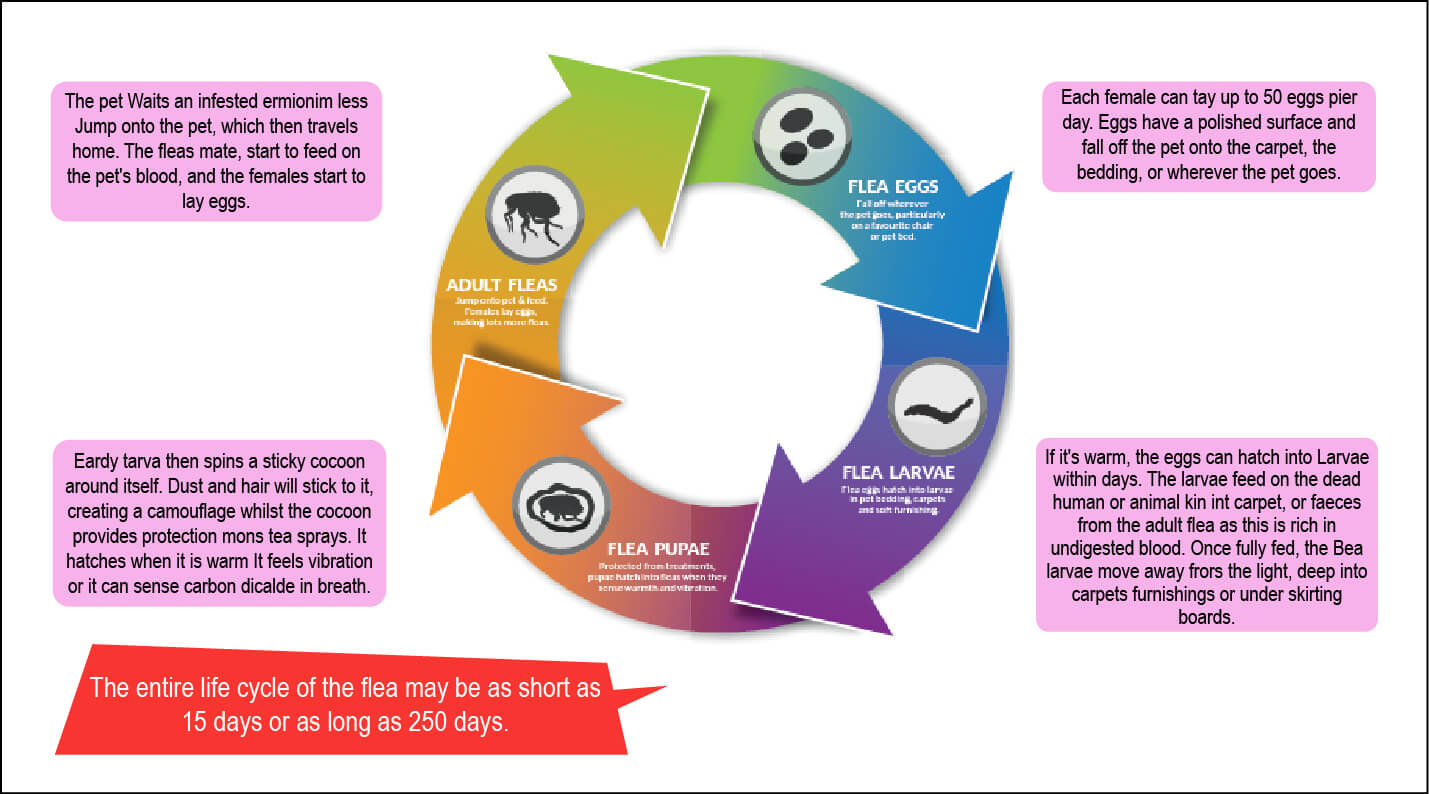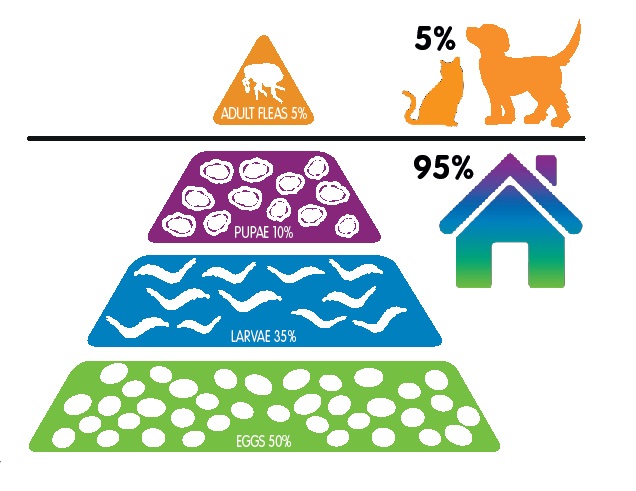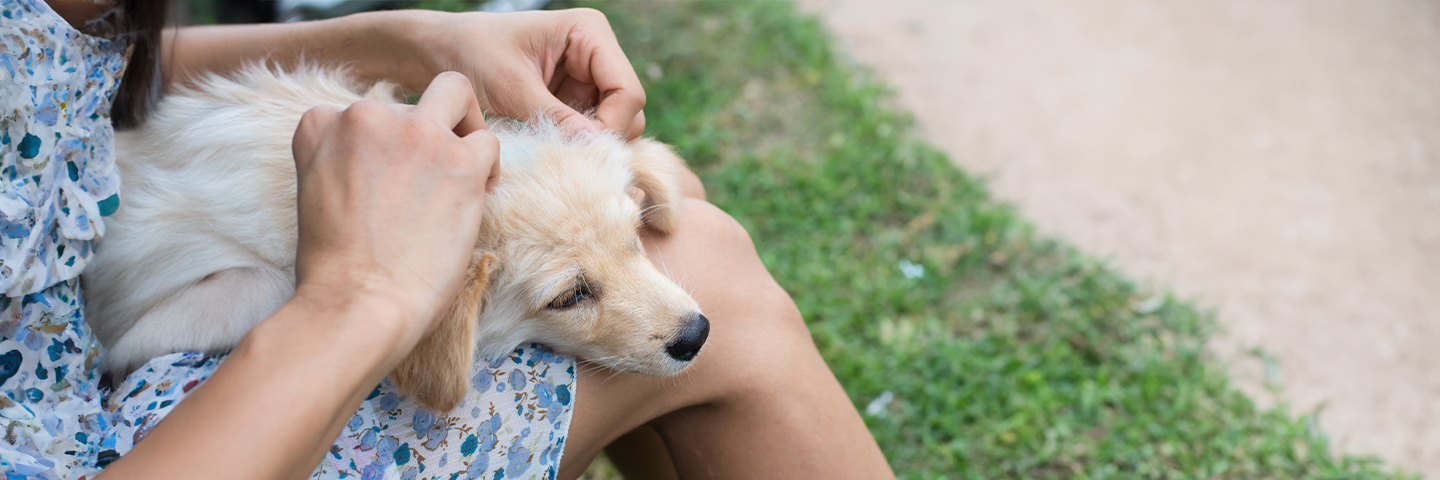7 things you need to know about fleas
Fleas are blood-sucking parasites that have existed on this planet for more than 50 million years. They feed on the blood of our pets and can cause them much discomfort and stress. In this article, we would like to inform you of the 10 most important things that you should definitely know about fleas.
Only 5% of fleas live on the animal.
The other 95% are mostly invisible, living in the environment of the animal. This means they could be living anywhere in your house, but mostly in warm and moist places, such as carpets, pillows, beds and any other place your pet has access to. Without treating the environment, fleas can be a permanent problem, which is no longer restricted to the summer months only. Warm, damp conditions are great for fleas and central heating can, unfortunately, ensure perfect conditions in a house all year round.
A flea can lay up to 50 eggs a day!
As soon as fleas hop onto a pet, they will begin to suck its blood. After 36 hours, the adult female flea will lay its first eggs. A female flea may lay approximately 1,350 eggs in her entire lifetime. With these kinds of numbers, a full-blown flea infestation, that might even be termed a plague, can develop very quickly. All flea eggs have shiny shells and so fall from the pet’s coat, landing in the environment.
Pupaes can survive for over 140 days in their suspended state of animation
Flea eggs will hatch after 5-10 days, depending on temperature and humidity. The larvae crawl out of the eggs and feed on shed skin and the faecal matter from adult fleas, which also falls from the coat and contains undigested blood (which is a fantastic nutrient source for the developing larvae.) In order to grow, the larvae will shed their skin twice, taking approximately 5-10 days. They prefer a warm, moist environment and move away from direct light to avoid drying out. Eventually, the larvae will pupate. This is when the body tissues of the immature, laval stage reorganize themselves into the adult body layout. Most pupae hatch into adult fleas after 4 days, but as said before, they can survive for over 140 days until the most beneficial circumstances arise (temperature, humidity and/or the presence of a host animal).
Fleas are mostly located around the waist, neck, behind the ears and in the “armpits”.
To find out if a pet is suffering from a flea infestation, their coat should be thoroughly combed with a proper flea comb. The above-listed areas should be checked first, as these places are the warmest and fleas will often gather in such areas. Clear indications of a flea infestation are when the cat or dog is constantly scratching him/herself, over-grooming and tiny black specks on fur and in beds can be seen. Often it is obvious that the pet is suffering from unusual itchiness and they will become agitated.
Your pet can get worms from fleas.
Fleas act as a host for some types of tapeworm, so a flea invasion often brings a worm infestation along with it. Tapeworms are made up of multiple segments. The segments, full of eggs, are passed into the faeces a few at a time. These worms will not pass naturally; therefore it is necessary to worm your pet after having had a flea infestation.
To combat fleas effectively, it is important to disrupt the flea life cycle.
Just treating the fleas on the animal, will not solve a flea problem. All aspects of the flea life cycle need to be taken into consideration; the mature fleas on the pet and the immature stages in the living environment. Households, flooring and pet bedding all need to be treated with suitable houshold insecticides, in the form of either sprays, powders or fumigators. Insect Growth Regulators are chimcals that mimic natural compounds in the flea’s metabolism. These metabolic pathways do not exits in mammals, so these products are very safe to use. IGRs will interrupt the life cycle of egg-larva-pupa-flea by preventing one stage from developing to the next.

There are many different products available to help you combat a flea infestation.
An on-animal treatment (such as an insecticidal spot on) will kill any fleas that are either living on, or jump onto, the pet, as well as preventing any more eggs from being laid. However, following the first application, it is incredibly important to preven any fleas already living in the environment from completing their lifecycle. Some pet owners can be disheartened by an apparent lack of efficiency from flea control products when they see fleas on recently treated pets. If they have not treated the environment, newly hatched fleas will continue to hop onto their pets until they do something about it. Due to the variable timespan that flea pupae can take to develop and hatch, it may be months before they are affected by an insecticidal treatment.
We have developed a full Beaphar flea treatment range that can be used to help you combat a flea infestation if you are being plagued by one. On top of that, we also have excellent repellents that will help you avoid such a problem from arising in the first place.
 Dog Care
Dog Care Events
Events



